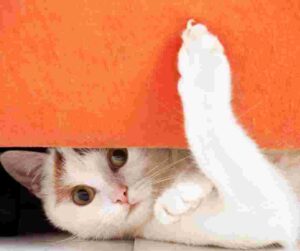
Bringing a new cat into your home is an exciting and rewarding experience. However, some cats may exhibit “ghost cat” behavior, hiding and being elusive as they adjust to their new surroundings. This article aims to provide practical advice to help new cat owners navigate this adjustment period and encourage their furry friend to come out of their shell.

Why Do Cats Hide?
Understanding the reason behind a cat’s hiding behavior is important to provide reassurance to new cat owners. Cats naturally seek out hiding spots as a means of self-preservation and to feel secure in unfamiliar environments. Hiding is a normal response to stress or anxiety during the adjustment period.
It’s crucial to remember that a cat’s tendency to hide is not indicative of their temperament or personality. With patience, love, and a supportive environment, your cat will gradually gain confidence and reveal their true nature as they feel more comfortable in their new home.
Tips For Helping Your New Cat Adjust to Your Home

- Give Your Cat Space:
- Create a safe and comfortable space for your cat to retreat to, such as a quiet room with bedding, food, water, and a litter box.
- Avoid overwhelming the cat with too much human interaction initially, as this can cause stress and hinder the adjustment process.
- Allow your cat to explore their surroundings at their own pace, providing hiding spots like cardboard boxes or cat trees for them to feel secure.
- Be Patient and Respectful:
- Understand that each cat has its own personality and may take varying amounts of time to feel comfortable. Respect their need for solitude and don’t force interactions.
- Avoid reaching into hiding spots or dragging the cat out. Instead, create positive associations by sitting nearby, offering treats, or engaging in calm play with interactive toys.
- Use Positive Reinforcement:
- Reward desired behaviors, such as coming out of hiding, with treats, praise, or gentle petting. This encourages your cat to associate positive experiences with being more visible.
- Gradually introduce activities that your cat enjoys, such as interactive play sessions or brushing, to build trust and strengthen the bond between you.
- Provide Environmental Enrichment:
- Offer a variety of toys, scratching posts, and climbing structures to stimulate your cat’s natural instincts and provide outlets for play and exploration.
- Consider using interactive food puzzles or treat-dispensing toys to engage your cat mentally and encourage them to come out of their hiding spots.
- Seek Professional Advice if Needed:
- If your cat’s hiding behavior persists for an extended period or becomes excessive, it’s advisable to consult a veterinarian or a professional animal behaviorist for further guidance.
- They can assess if there are any underlying health concerns or provide tailored advice to help your cat adjust and overcome their fear or anxiety.
Remember that each cat is unique and may require different approaches and timelines to adjust to their new home. Patience, understanding, and creating a supportive environment are key to helping your “ghost cat” feel safe and secure.
With time and positive reinforcement, your new feline companion will gradually come out of hiding, revealing their true personality and forming a deep bond with you.
Copyright 2023
Deborah G. Moore
Pet Rehoming Network
All rights reserved.

